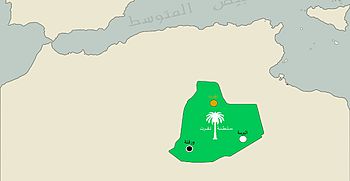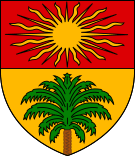Sultanate of Tuggurt facts for kids
Quick facts for kids
Sultanate of Tuggurt
سلطنة تقرت (ar)
|
|||||||
|---|---|---|---|---|---|---|---|
| fifteenth century–1871 | |||||||

Location of the Sultanate of Touggourt in southern Algeria
|
|||||||
| Capital | Tuggurt | ||||||
| Common languages | Arabic | ||||||
| Religion | Islam | ||||||
| Government | Monarchy | ||||||
| Sultan | |||||||
|
• N/A
|
N/A | ||||||
|
• 1852–1854
|
Sulayman IV | ||||||
| History | |||||||
|
• Sultanate of Tuggurt founded
|
fifteenth century | ||||||
|
• Became Vassal of Regency of Algiers
|
1552 | ||||||
|
• Independence from Regency of Algiers
|
1812-1827 | ||||||
|
• Abolished by French colonial authority
|
1854 | ||||||
|
• Rebellion against French colonial authority
|
1871 | ||||||
|
|||||||
| Today part of | Algeria | ||||||
The Sultanate of Tuggurt was an old kingdom in what is now Algeria. It existed from the 1400s until 1881. This kingdom was ruled by leaders called sultans from the Banu Djellab family. It covered the city of Tuggurt and the areas around it, including the Oued Righ valley.
Contents
How the Sultanate Started
Before the Sultanate, Tuggurt was part of the Hafsid dynasty's lands. Like many cities, Tuggurt sometimes rebelled and stopped paying taxes. For example, a local leader named Yusuf ibn Hasan rebelled against the Hafsid Sultan Abu 'Amr 'Uthman. The Sultan had to take back control of Tuggurt twice, in 1449 and 1465. The Sultanate of Tuggurt began when the Hafsid dynasty became weak and eventually fell.
History of the Tuggurt Sultanate
The Sultanate was started in the 1400s by the Banu Djellab family. Their exact beginnings are not fully known. They said they were the last family members of the Marinid Sultanate, a powerful kingdom from Morocco. Because of this, they copied some of the Moroccan sultans' ways of ruling. For example, they had a special guard made up of Black soldiers.
Founding by Sulayman ibn Djellab
According to some history books, the founder was a man named Sulayman ibn Djellab. He was a Moroccan prince connected to the Marinid family. After he returned from a religious journey called the hajj, he built a mosque in the area. With help from local nomadic tribes, he became known as their ruler.
Sulayman felt strong enough to keep some local ways of governing. He kept the djemaa, which was a council, and he could choose who was on it. He also created his own army of 500 horsemen. This army helped him keep peace, stop rebels, and collect taxes. Sheikh Soliman also made a deal with the powerful Douaouda family. They controlled many nomadic tribes in the plains. He married his daughter to the head of this family, Ben Sakheri, who was a very important leader.
Facing the Regency of Algiers
In the 1500s, the Sultanate of Tuggurt had to deal with the powerful Regency of Algiers. In 1552, Salah Raïs, a leader from Algiers, led an army against Tuggurt. The Banu Djellab leaders gave up because the enemy had strong artillery (big guns). After this, the Sultanate of Tuggurt became a vassal state of Algiers. This meant they had to pay tribute (money or goods) to Algiers.
Rulers of Tuggurt
Here is a list of the known leaders of the Sultanate, including one female ruler:
- Ali II (N/A)
- Mabruk (Mubarak) (N/A)
- Ali III (N/A)
- Mustafa (N/A)
- Sulayman III (N/A)
- Ahmad II (1729-N/A)
- Muhammad I al-`Akhal (N/A)
- Ahmad IV (N/A)
- Farhat (N/A)
- Ibrahim (N/A)
- Abd al-Qadir I (1st time) + Ahmad V (N/A)
- Khalid (N/A)
- Abd al-Qadir I (2nd time) (N/A)
- Umar bin Bu-Kumetin (175.-1759)
- Muhammad II (1759–1765)
- Umar II bin Muhammad (1765–1766)
- Ahmad VI (1766–1778)
- Abd al-Qadir II (1778–1782)
- Farhat II (1782–1792)
- Ibrahim II (1792–1804)
- al-Khazan (1804)
- Muhammad III (1804–1822)
- `Amar (`Amir) II (1822–1830)
- Ibrahim III (1830–1831)
- `Ali IV bin al-Kabir (1831–1833)
- `Aisha (Aichouch) (female) (1833–1840)
- `Abd ar-Rahman (1840–1852)
- `Abd al-Qadir III (1852)
- Sulayman IV (1852–1854) (last)
See also
 In Spanish: Sultanato de Tuggurt para niños
In Spanish: Sultanato de Tuggurt para niños


